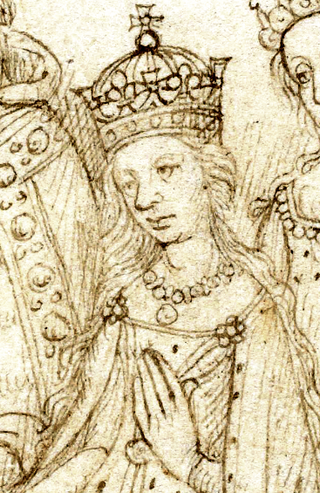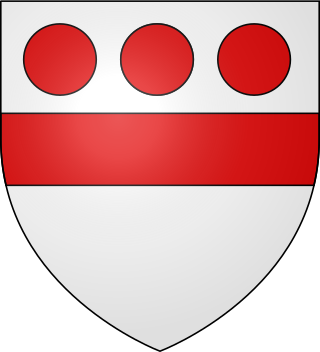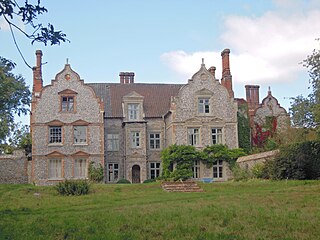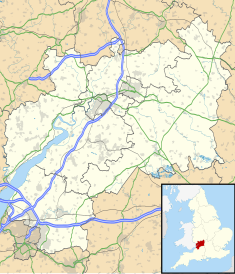
Catherine of Valois or Catherine of France was Queen of England from 1420 until 1422. A daughter of King Charles VI of France, she married King Henry V of England and was the mother of King Henry VI. Catherine's marriage was part of a plan to eventually place Henry V on the throne of France, and perhaps end what is now known as the Hundred Years' War. But, although her son Henry VI was later crowned in Paris, the war continued.

Earl of Essex is a title in the Peerage of England which was first created in the 12th century by King Stephen of England. The title has been recreated eight times from its original inception, beginning with a new first Earl upon each new creation. The most well-known Earls of Essex were Thomas Cromwell, chief minister to King Henry VIII, Sir William Parr (1513-1571) who was brother to Queen Catherine Parr who was the sixth wife of King Henry VIII, and Robert Devereux, 2nd Earl of Essex (1565–1601), a favourite of Queen Elizabeth I who led Essex's Rebellion in 1601.

John Canfield Spencer was an American lawyer, politician, judge and United States Cabinet secretary in the administration of President John Tyler.

Viscount Hereford is the oldest extant viscountcy in the Peerage of England, making the holder the Premier Viscount of England. The title was created in 1550 for Walter Devereux, 10th Baron Ferrers of Chartley.
Earl of Hereford is a title in the ancient feudal nobility of England, encompassing the region of Herefordshire, England. It was created six times.

Southam is a village in Gloucestershire, England, located on the outskirts of Cheltenham. Its main features are a Manor House, which has now been converted to a hotel, a 12th Century Church and the Gloucestershire Warwickshire Railway, which runs through the outskirts of the village.
William Wilkins was an English architect, classical scholar and archaeologist. He designed the National Gallery and University College London, and buildings for several Cambridge colleges.

Baynard's Castle refers to buildings on two neighbouring sites in the City of London, between where Blackfriars station and St Paul's Cathedral now stand. The first was a Norman fortification constructed by Ralph Baynard, 1st feudal baron of Little Dunmow in Essex, and was demolished by King John in 1213. The second was a medieval palace built a short distance to the south-east and later extended, but mostly destroyed in the Great Fire of London in 1666. According to Sir Walter Besant, "There was no house in [London] more interesting than this".

Miles FitzWalter of Gloucester, 1st Earl of Hereford was a great magnate based in the west of England. He was hereditary Constable of England and Sheriff of Gloucestershire.
Fettiplace is an English family name, allegedly of Norman descent, originating with a landed gentry family chiefly of Berkshire and Oxfordshire, from which came a baronetical line, extinct.
Glasbury, also known as Glasbury-on-Wye, is a village and community in Powys, Wales. The village lies at an important crossing point on the River Wye, connecting the historic counties of Brecknockshire and Radnorshire, and is located just outside the Brecon Beacons National Park, north of the Black Mountains. The village is split between the communities of Glasbury and Gwernyfed. The nearest town is Hay-on-Wye, some 4 miles (6 km) to the north east. The nearest city is Hereford in England, some 25 miles (40 km) to the east. Glasbury is a popular location for river fishing, canoeing and kayaking. The population of Glasbury community in Radnorshire was 994, in 1841 it was 838.

Sir Walter Devereux, 5th Viscount Hereford, 2nd Baronet of Castle Bromwich, was an English politician who sat in the House of Commons at various times, between 1614 and 1624, before succeeding to the family Viscountcy in the peerage of England.

Nature in Art is a museum and art gallery at Wallsworth Hall, Twigworth, Gloucester, England, dedicated exclusively to art inspired by nature in all forms, styles and media. The museum has twice been specially commended in the National Heritage Museum of the Year Awards.
Walter Wilkins, of Maesllwch, Radnorshire and Wallsworth Hall, Gloucestershire was an English Member of Parliament.
The Gurneys were an influential family of English Quakers, who had a major part in the development of Norwich, England. They established Gurney's Bank in 1770, which merged into Barclays Bank in 1896. They established successful breweries. A number of family members were abolitionists. Members of the family still live in the United Kingdom.

Edward Haycock Sr. was an English architect renowned for his work in the West Midlands and central and southern Wales during the late Georgian and early Victorian periods.

Nathaniel Prime was a New York broker and banker.

Hoveton Hall in the parish of Hoveton in Norfolk is a Regency-style country house made of gault brick with a slate roof. It was built between 1809 and 1812, on or near the site of the previous ancient manor house of the same name, by Mrs Christabell Burroughes (1764-1843), daughter and heiress of Henry Negus (1734-1807) of Hoveton Hall, an attorney, and wife of James Burkin Burroughes (1760-1803) of Burlingham Hall, Norfolk. The architect was Humphry Repton. It is a well-preserved historic house of significance on the English Heritage Register. The Negus family had been seated at Hoveton Hall for several generations. The surrounding estate today consists of 120 acres of gardens and parkland and 450 acres of arable land as well as picturesque woodland. The gardens are open to the public during part of the year and there are facilities available for accommodation and special events including weddings.

Wiveton Hall is a country house in Wiveton, Norfolk, England. It is Grade II* listed. It was built in 1652 and extended in 1908. However there are remains of an older building in the garden which could date back to 1280. It was the residence of many notable people over the next three centuries and is now the home of the MacCarthy family. The Hall provides holiday cottage accommodation, a restaurant café, a farm and gift shop and has garden tours. The West Wing is available for weddings and other special events.
Walter Wilkins was a British politician.
















